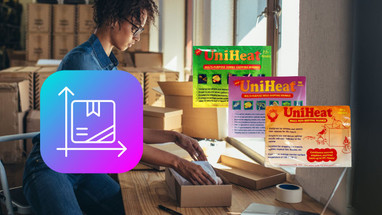Posted by UniHeatPacks on 17th Oct 2025
Choosing the Right Box Size & Insulation for Heat Packs
Shipping temperature-sensitive goods safely depends on balance. Too little insulation and heat escapes; too much and your UniHeat packs can suffocate. This article explains how to choose the correct box size and insulation for live animals, aquatic corals, plants, and other delicate items. For proven results, use UniHeat shipping warmers in 20hr, 40hr, 72hr, or 96hr formats depending on your transit time and weather.
1) Why Box Size Matters More Than You Think
The size of your shipping box directly affects airflow, heat retention, and pack performance. A box that’s too small traps heat and starves oxygen; too large and warm air dissipates before reaching your product. Aim for a tight but breathable fit.
- Small boxes (under 8x8x8"): Great for short routes and mild weather; use one 40hr pack with light insulation and 2 vent holes.
- Medium boxes (10–14” sides): The most versatile size for most live shipments. One or two 72hr packs usually suffice.
- Large boxes (16”+): Ideal for multiple containers or very cold weather; use 2+ warmers spaced apart, and confirm ventilation at multiple points.
Tip: Always account for the insulation liner thickness inside your outer carton. A “12-inch” box with 1-inch foam walls only leaves 10 inches of usable space inside.
2) Choosing the Right Insulation Type
Insulation creates a thermal barrier that moderates rapid temperature changes. The ideal setup prevents freezing air from entering while still allowing gentle oxygen flow to the heat packs.
- Foam coolers: The gold standard for live animal and coral shipments. Excellent insulation and structure.
- Insulated liners: Flexible and lightweight, ideal for plants or smaller goods where space matters.
- Reflective bubble wrap: Works for mild to moderate cold. Line the walls or wrap individual items for added stability.
- Double-boxing: Recommended for severe cold snaps—place a foam cooler inside a corrugated outer carton.
Rule of thumb: Each extra layer of insulation adds about 5–10°F of internal stability but reduces available air for the warmer. Vent accordingly.
3) Ventilation and Oxygen Flow
UniHeat packs generate warmth through controlled oxidation. Without oxygen, they slow or stop. Every well-insulated setup must still “breathe.”
- Vent holes: Punch 2–4 pencil-size holes in the outer box only—never the inner foam cooler.
- Placement: Top edges or corners are ideal so warm air circulates without drafts.
- Avoid over-venting: Too many holes waste heat; too few starve the pack. Two 1/4” holes per side usually balance airflow for 1–2 warmers.
Pro Tip: Warmers need space to “breathe” inside the box. Use cardboard spacers or air gaps around them—don’t tape warmers directly to foam walls or wrap them tightly in plastic.
4) Step-by-Step: Assembling the Ideal Setup
- Step 1 – Select the outer box: Choose a strong corrugated carton rated for 200# burst or higher.
- Step 2 – Add insulation: Line with foam panels, insulated liner, or bubble wrap, leaving a small air gap for circulation.
- Step 3 – Place heat pack: Activate 20–30 minutes before sealing. Tape to a cardboard spacer near the top interior.
- Step 4 – Load items: Secure contents centrally, away from direct contact with the heat pack. Use void fill for stability.
- Step 5 – Ventilate and label: Add two vents per side on the outer box, and mark “Temperature Sensitive – Protect From Cold.”
5) Common Mistakes to Avoid
- Oversized boxes: Wastes heat and creates dead air zones.
- Airtight insulation: Starves oxygen and shortens warmer lifespan.
- No spacer layer: Direct contact causes overheating and condensation.
- Wrong duration: 40hr packs are insufficient for 2-day winter routes; use 72hr or 96hr instead.
Frequently Asked Questions
What’s the best box size for one 72hr warmer?
A medium 10–12" insulated shipper provides good balance between oxygen flow and heat retention for one UniHeat 72hr pack.
Can I reuse insulated boxes?
Yes, if foam or liners are dry and intact. Check for cracks or compression that reduce insulation efficiency.
Do warmers need to touch the liner?
No—keep a cardboard layer or air gap between. Direct contact reduces oxygen flow and may trap condensation.
About UniHeat: UniHeat has been the trusted name in animal and perishable shipping since 1996. Our oxygen-activated warmers are designed for safe, consistent heat across all climates. Explore the full range at UniHeat.us.

